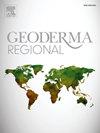人为因素和土壤特性对地中海南部农业生态系统蚯蚓多样性的影响
IF 3.3
2区 农林科学
Q2 SOIL SCIENCE
引用次数: 0
摘要
这项研究考察了阿尔及利亚东北部安纳巴地区农业生态系统中蚯蚓的生物多样性,重点是农业耕作方式和土壤环境条件对这些物种的影响。已鉴定出 Lumbricidae 和 Megascolecidae 科的 7 种蚯蚓,其中 5 种是该地区的新记录。在人类活动密集的地区,蚯蚓的数量和多样性都有所下降,而在农业活动强度较低的地区,蚯蚓的多样性水平较高。与土地利用和植物多样性相关的土壤特性的变化非常显著。密集型农业生产方式导致土壤特性改变,如 pH 值、导电率(EC)和盐度升高,而有机添加物则增加了有机碳和营养多样性。钙和镁等必需营养元素对蚯蚓的活力至关重要,而高水平的 pH 值、盐度和导电率会减少蚯蚓的数量。典型对应分析支持这些发现。总之,农业实践和土壤环境条件对蚯蚓的数量有很大影响,这说明需要采用可持续的方法来保护地下生物多样性和生态系统服务。本文章由计算机程序翻译,如有差异,请以英文原文为准。
Influence of anthropogenic factors and soil properties on earthworm diversity in southern Mediterranean agroecosystems
This study examines the biodiversity of earthworms in agroecosystems in the Annaba region of northeastern Algeria, focusing on the impact of agricultural practices and soil environmental conditions on these species. Seven earthworm species from the Lumbricidae and Megascolecidae families have been identified, of which five are new records for this region. Areas with intensive human activity exhibited a decrease in earthworm abundance and diversity, whereas areas with less intensive agricultural practices showed higher levels of earthworm diversity. Variations in soil properties related to land use and plant diversity were notable. Intensive agricultural practices resulted in altered soil characteristics, such as higher pH, electrical conductivity (EC), and salinity, while organic amendments increased organic carbon and nutritional diversity. Essential nutrients, such as calcium and magnesium, are crucial for earthworm vitality, while high levels of pH, salinity, and EC can reduce their populations. Canonical Correspondence Analysis supports these findings. In summary, agricultural practices and soil environmental conditions significantly influence earthworm populations, underscoring the need for sustainable methods to preserve underground biodiversity and ecosystem services.
求助全文
通过发布文献求助,成功后即可免费获取论文全文。
去求助
来源期刊

Geoderma Regional
Agricultural and Biological Sciences-Soil Science
CiteScore
6.10
自引率
7.30%
发文量
122
审稿时长
76 days
期刊介绍:
Global issues require studies and solutions on national and regional levels. Geoderma Regional focuses on studies that increase understanding and advance our scientific knowledge of soils in all regions of the world. The journal embraces every aspect of soil science and welcomes reviews of regional progress.
 求助内容:
求助内容: 应助结果提醒方式:
应助结果提醒方式:


